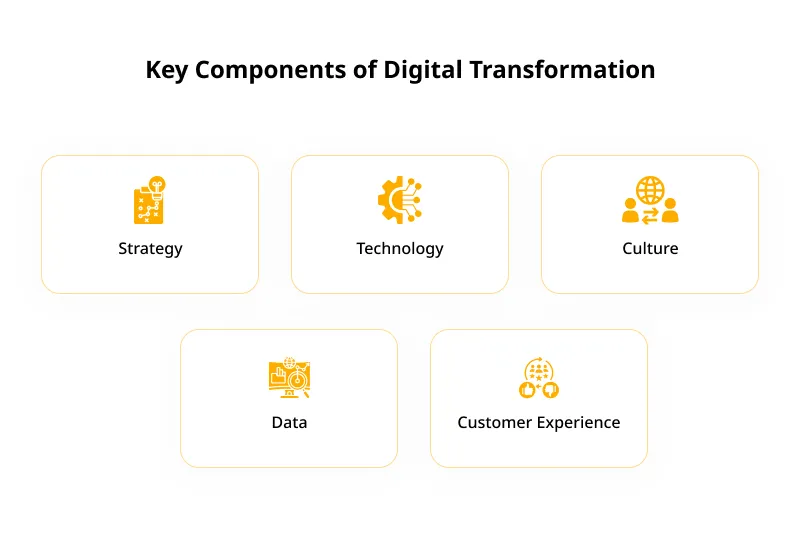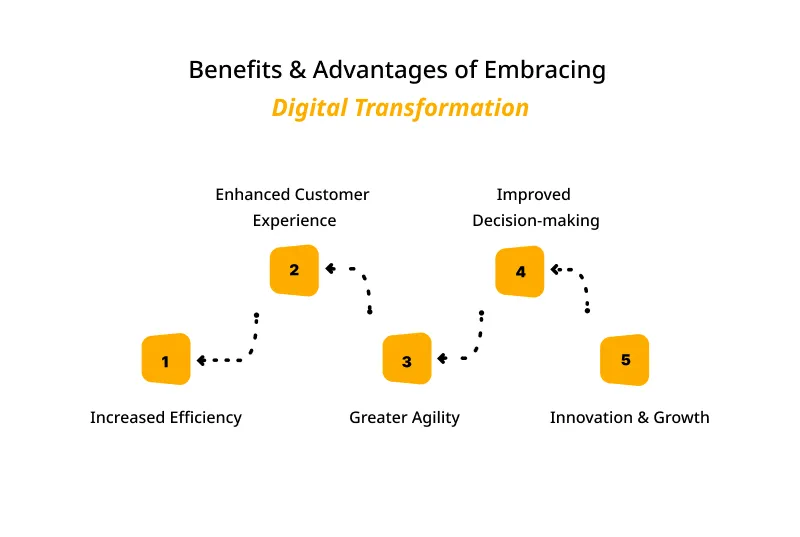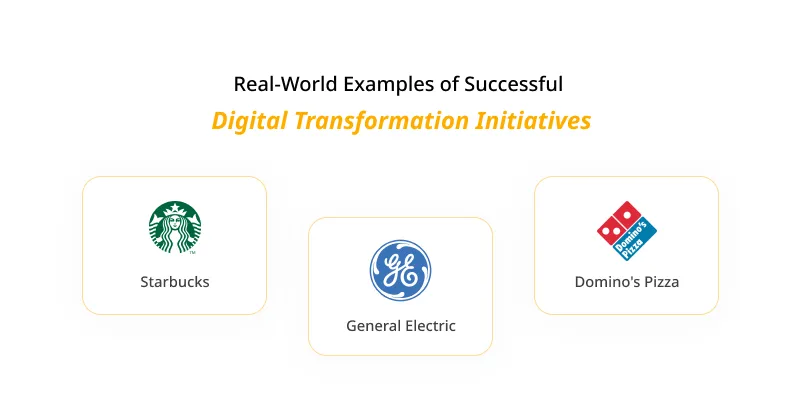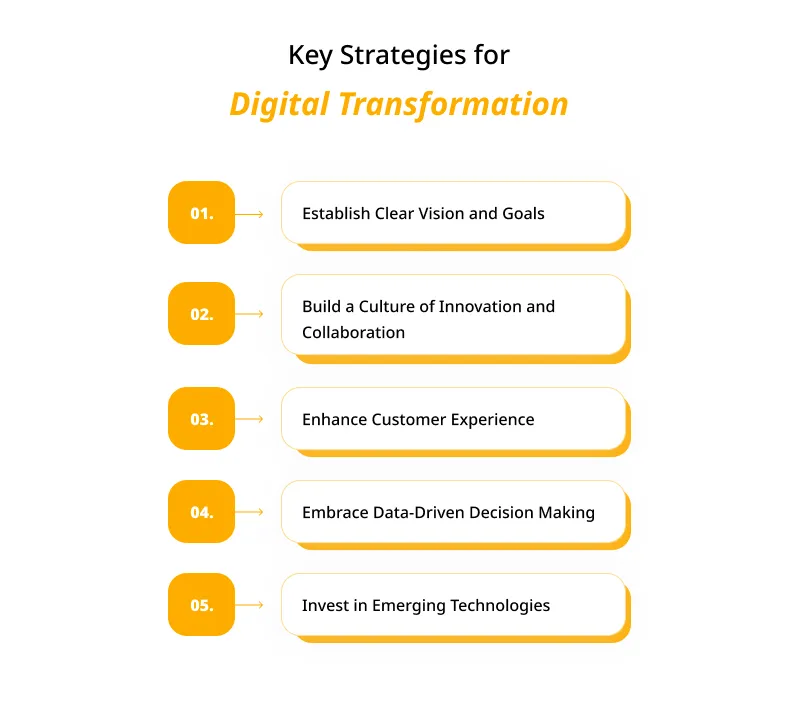Digital transformation for businesses is not an option but a necessity for them to stay relevant & competitive in the digital age. – Satya Nadella
Businesses are always in pursuit of staying competitive in a quick-paced digital landscape, necessitating them to adapt and grow to accommodate the dynamic market needs. The digital transformation journey within a business can be an exciting and overwhelming experience.
In this post, we have shared the key strategies to upgrade your business and essential tips to assist you with digital transformation for businesses. This will set your organization up for a long-term prosperous future.
Understanding Digital Transformation
In the age of dynamic digital economy, implementing digital transformation strategies is essential to stay ahead in the game. Businesses that identify the components of digital transformation and gain insights from real-world apps are well-positioned to drive innovation & secure long-term success.
Key Components of Digital Transformation
Digital transformation services for small businesses fundamentally change how they operate and deliver customer value.
The key components of digital transformation for business include:
- Strategy: Emphasize on having a clear vision & roadmap for digital transformation aligned with the organization’s core business objectives.
- Technology: Implement cutting-edge digital tools & platforms to streamline operations, enhance collaboration, improve decision-making, etc.
- Culture: Foster a culture of innovation, agility, and continuous learning to support adopting new technologies/processes.
- Data: Leverage data analytics & insights to drive informed decision-making and optimize business performance.
- Customer Experience: Enhance customer interactions and experiences through personalized, seamless, and omnichannel touchpoints.
Schedule a consultation with our experts and discover tailored digital transformation Solution
Benefits & Advantages of Embracing Digital Transformation
Embracing digital transformation can result in:
- Increased Efficiency: Automation and streamlined processes reduce manual tasks, improving productivity and cost savings.
- Enhanced Customer Experience: Digital technologies enable businesses to deliver personalized, seamless, engaging experiences across multiple channels.
- Greater Agility: Digital transformation allows organizations to adapt quickly to market changes and customer demands, ensuring long-term competitiveness.
- Improved Decision-making: Data-driven insights empower businesses to make informed decisions & optimize performance.
- Innovation & Growth: Digital transformation for businesses fosters innovation and opens up new opportunities for business expansion & revenue generation.
Also Read: Know All-New Digital Transformation Strategies & Benefits For Your Business
Way to Assess Your Business’s Digital Readiness
It’s crucial to evaluate your organization’s digital readiness before embarking on the digital transformation journey for business. This process involves three key steps:
1. Thoroughly evaluate your current digital capabilities
Take stock of your existing digital infrastructure, tools, and processes. This includes assessing your IT systems, software, data management practices, and employee skill sets.
By understanding your current digital landscape, you can identify strengths to build upon and weaknesses that need to be addressed.
2. Identify areas that require improvement or modernization
Once you have a clear picture of your current digital capabilities, pinpoint the areas that need enhancement or modernization. This involves upgrading outdated software, implementing new technologies, and streamlining inefficient processes.
You must remember that digital transformation is not a one-size-fits-all approach for businesses. It is essential to prioritize improvements based on your organization’s unique needs & goals.
3. Analyze market trends and customer expectations to inform your strategy
Staying in tune with the current industry and consumer trends is imperative to guarantee that your digital transformation efforts will be on par with the market landscape.
Researching for emerging technologies, monitoring competitor activities, and gathering customer feedback to identify opportunities for innovation & growth.
By incorporating the above insights into your digital transformation strategy, you can better position your business for long-term success in this digital era.
Schedule a consultation with our experts to discuss your digital transformation goals.
Key Strategies for Digital Transformation
Businesses can unlock the full potential of digital transformation and thrive in the digital age by focusing on clear goals, fostering innovation, leveraging data, and investing in emerging technologies.
Have a look at the key steps to include in digital transformation strategy:
Step 1: Establish Clear Vision and Goals
Define your desired outcomes and objectives
Before you get started, make sure you know the particular results you wish to gain from digital transformation. It includes increased efficiency, improved customer experience, or new sources of income. So, having clear objectives will keep your projects focused on getting better outcomes.
Align your digital transformation efforts with your overall business strategy
Ensure that your digital transformation initiatives are aligned with your organization’s broader strategic goals. This will help create a cohesive approach to transformation and maximize the impact of your efforts.
Strategy 2: Build a Culture of Innovation and Collaboration
Foster a mindset of continuous learning and experimentation
It is important to urge employees to experiment with new concepts, take risks, review and refine their output to foster a culture of innovation. This will nurture a setting that encourages progress & growth. It further allows digital transformation to flourish.
Encourage cross-functional collaboration and breaking down silos
Interdepartmental collaboration within the company should be actively encouraged to bridge any existing gaps and optimize the exchange of innovative ideas & knowledge. It will ultimately drive forward digital transformation initiatives.
Also Read: Industry 5.0: How IT Is Transforming the Manufacturing Landscape
Strategy 3: Enhance Customer Experience
Understand customer needs and preferences
Research can provide valuable information about customers’ needs, likes, and areas of difficulty. With this information, digital solutions can be tailored to optimize their unique experience.
Implement digital solutions to improve customer interactions and satisfaction
It is possible to construct personalized, comprehensive, and stimulating experiences for customers through every stage of interaction by utilizing digital advancements. This will heighten customer contentment & dedication and, consequently, enhance business expansion.
Also Read: Top 22 Digital Transformation Companies You Must Consult To Adapt Modern Tech
Strategy 4: Embrace Data-Driven Decision Making
Collect and analyze relevant data for insights
Equipping your organization with appropriate data collection and analytics tools is essential to draw meaningful conclusions from various data sources. This will enable you to uncover valuable insights and identify trends that can guide your digital transformation endeavors.
Leverage data to drive strategic business decisions and optimizations
Use data-driven insights to make informed decisions, optimize processes, and drive continuous organizational improvement. This will help ensure that your digital transformation for business initiatives delivers maximum value and impact.
Strategy 5: Invest in Emerging Technologies
Identify technologies relevant to your industry and business goals
Keeping up-to-date with relevant industry advancements and patterns will help you recognize the potential of using these advancements to get an edge in the market. Aligning these technologies with your business goals would allow you to leverage the benefits of the available resources.
Explore the potential of artificial intelligence, cloud computing, Internet of Things (IoT), etc.
Exploring the power of contemporary technologies, like AI, cloud computing, and IoT, could generate new ideas and transformations within your company. This proactive step allows you to remain at the cutting edge of innovation and capitalize on emerging prospects for prosperity.
Incorporating the above essential digital transformation strategies will help companies upgrade their procedures, improve customer encounters, and facilitate sustained accomplishment in today’s rapidly progressing business arena.
Schedule a consultation with our experts and discover tailored digital transformation Solution
How to Overcome Challenges and Risks
Navigating the path of digital transformation could mean coming across obstacles and potential risks. To successfully modernize your business, addressing these challenges head-on is essential along with implementing strategies to mitigate risks.
Also Read: The Role of Digital Transformation in Product Engineering
A. Addressing common challenges in digital transformation:
Resistance to change and organizational culture issues
Resistance to change within the organization is one of the most prevalent barriers to digital transformation for businesses.
To overcome this, foster a culture of innovation and continuous improvement by encouraging open communication, providing ongoing training, and celebrating successes. Engaging employees in the transformation process and demonstrating the benefits of change can help alleviate fears and promote buy-in.
Budgetary constraints and resource allocation
Digital transformation often requires significant investments in technology, infrastructure, and personnel. To address budgetary concerns, prioritize initiatives that offer the greatest return on investment and align with your organization’s strategic goals. Additionally, consider leveraging partnerships and exploring alternative funding sources to help offset costs.
B. Mitigating risks and ensuring a smooth transition
Developing a comprehensive change management plan
A well-crafted change management plan minimizes disruption and ensures a smooth transition during digital transformation.
This plan should outline clear objectives, timelines, and responsibilities and provide guidelines for communication, training, and support. Regularly monitoring progress and adjusting the plan as needed can help keep your transformation efforts on track.
Prioritizing cybersecurity and data privacy measures
It is difficult to invest in cybersecurity and data privacy to keep your organization safe. Take precautionary steps such as encrypting data, enforcing multi-factor authentication, and performing frequent security audits to ensure the security of sensitive information and your organization’s safety from any possible risks.
Additionally, ensure compliance with relevant data privacy regulations to maintain customer trust and avoid costly penalties.
Also Read: How Artificial Intelligence Is Redefining Success Of Digital Transformation Strategies?
Some Successful Case Studies On Digital Transformation
Here we have highlighted real-world businesses that achieved successful digital transformations & also examined the strategies they employed & the outcomes they achieved.
Domino’s Pizza
Struggling to remain competitive in the fast-food market, Domino’s changed its approach by implementing digital transformation strategies & reinventing its customer experience.
By investing greatly in advanced technologies, such as online ordering, AI chatbots, and real-time delivery tracking systems, Domino’s Pizza has experienced tremendous success with a notable rise in sales & consumer approval.
Key to Domino’s success:
- Commitment to customer-centric innovation
- Developed digital solutions for unique user experience
As a result, Domino’s has become a market leader in the pizza delivery industry and continues to innovate with new technologies.
General Electric (GE)
On a worldwide level, GE understood that it had to innovate its systems and undergo digital conversion.
Utilizing more advanced analytics, the Internet of Things, and an emphasis on digital methods, the company became able to make operations more efficient, decrease expenses, and uncover new ways of earning profit.
Keys to GE’s digital transformation success:
- Clear vision and strong leadership
- Set ambitious goals & empowered employees to embrace change
- Successful transition from a traditional industrial manufacturer to a digital powerhouse
Now, GE’s digital initiatives continue to drive growth & create value for the company & its customers.
Also read: Measuring Success In Digital Transformation: Key Metrics And Indicators
Conclusion
So, we have explored various effective digital transformation strategies that can help you modernize your business successfully.
Examining the present status of your business and locating areas for enhancement enables you to set well-defined targets and devise a plan consistent with your organization’s goals.
Hence, digital transformation is imperative for companies seeking to thrive in today’s digital era.
By implementing the top strategies discussed in this blog – establishing a clear vision, fostering an innovative culture, prioritizing customer-centricity, embracing data-driven decision-making, and maintaining agility – you can confidently navigate the digital landscape and position your business for long-term success.
You may also contact ValueCoders, a leading digital transformation consultant in India since 2004.













